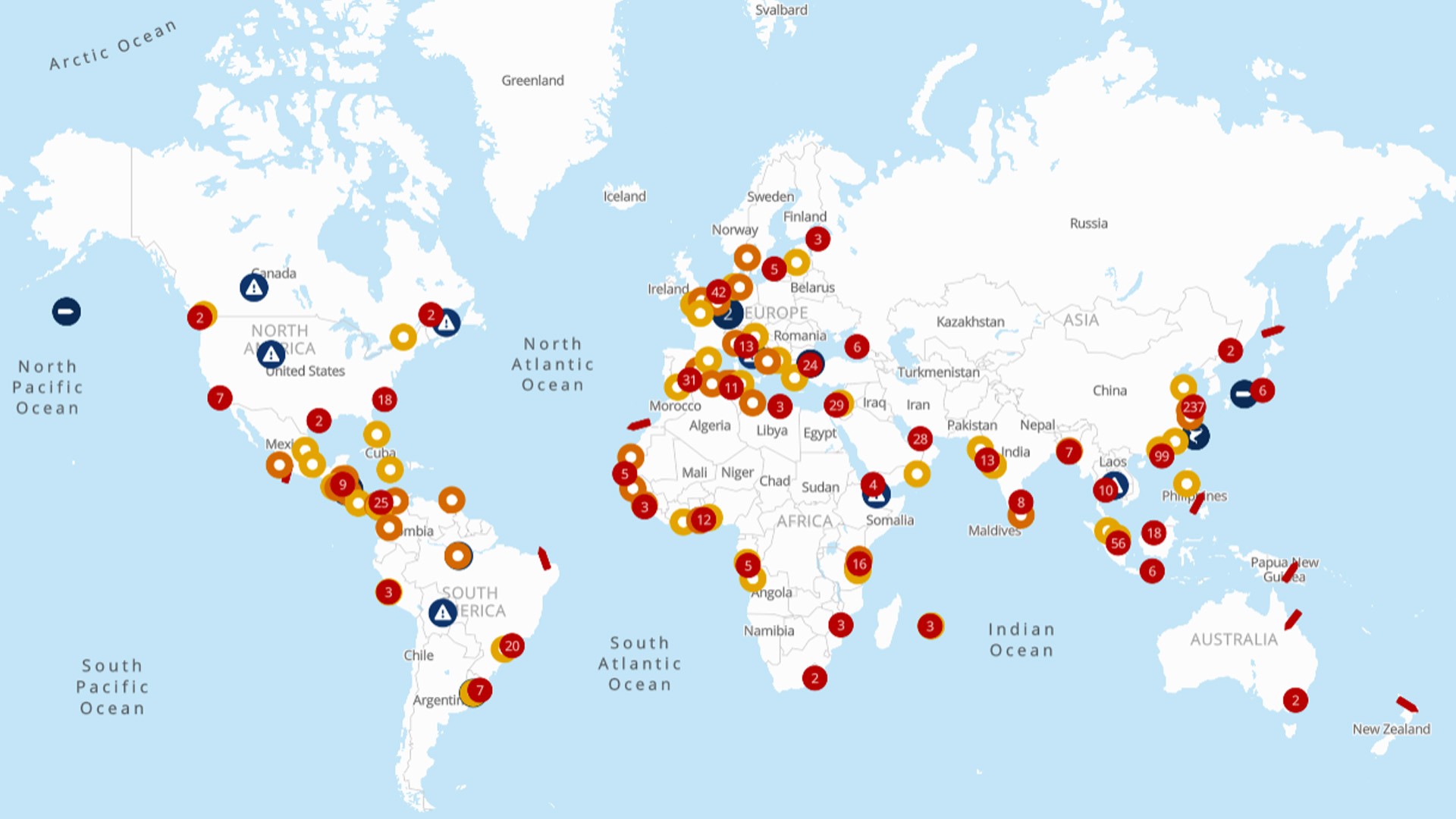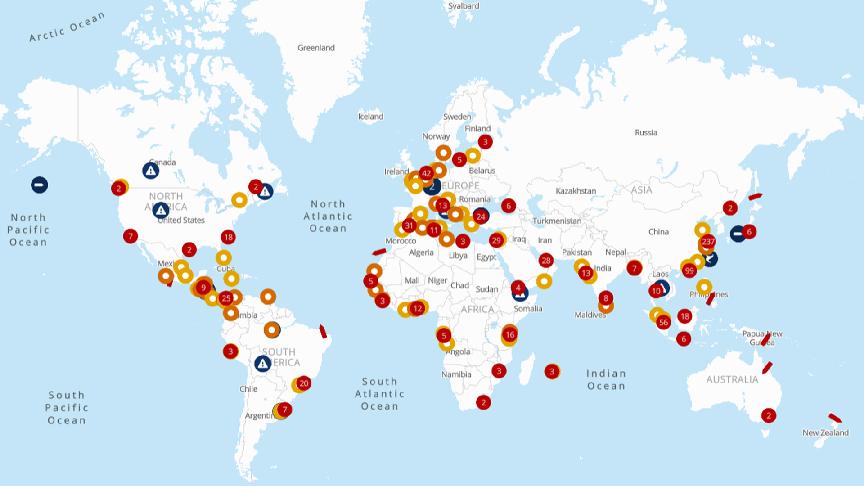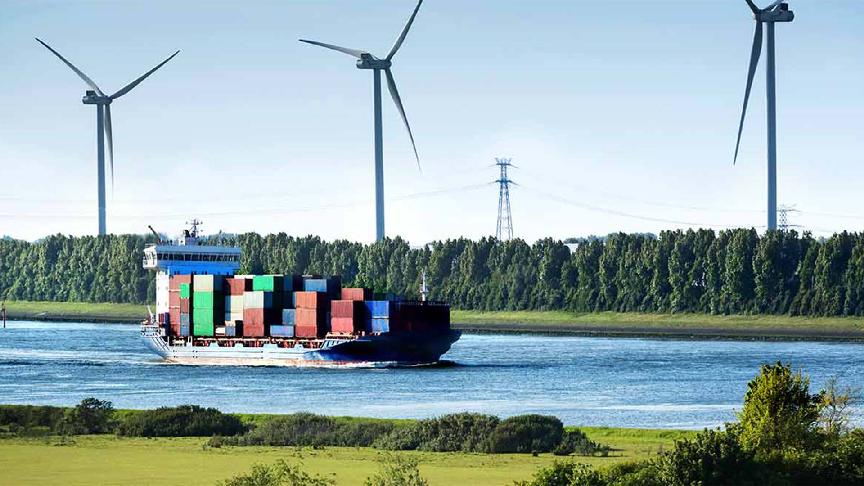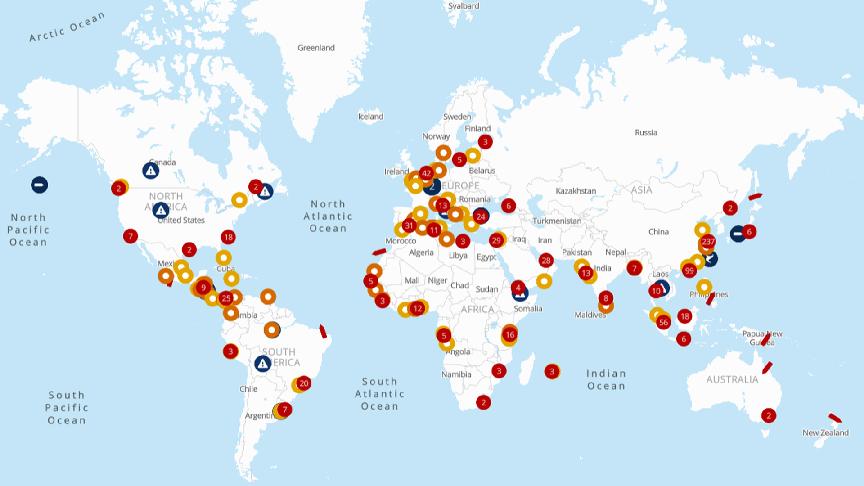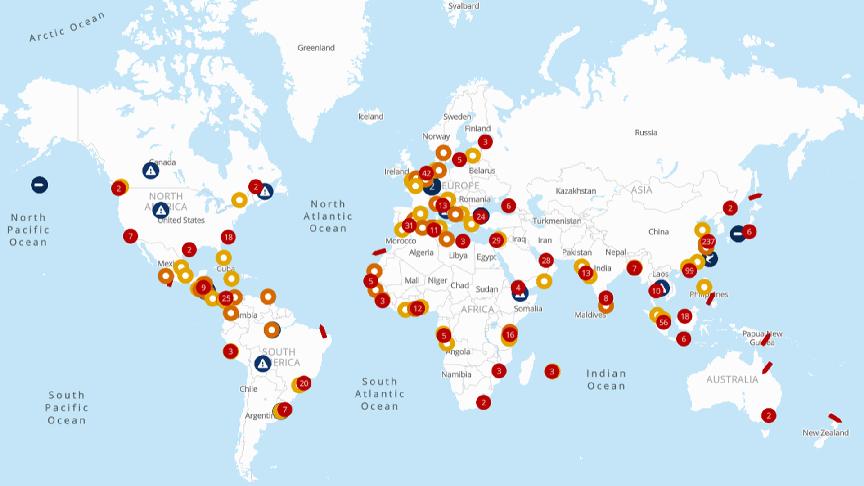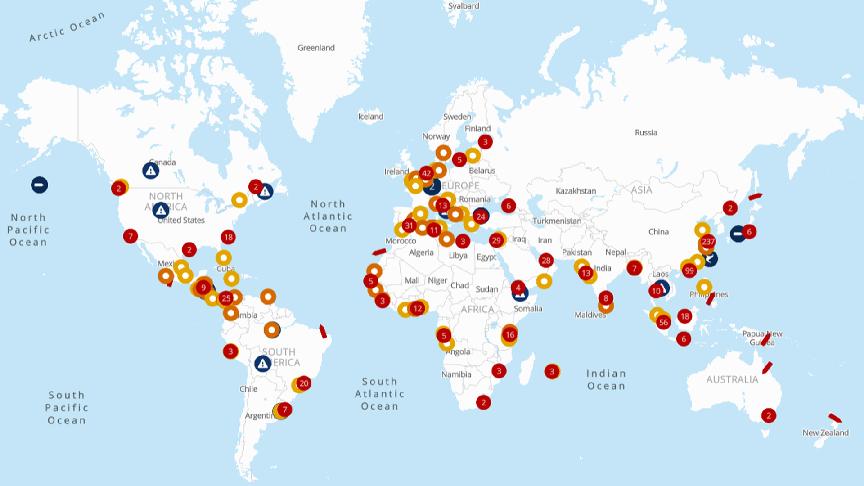- Stay ahead of supply chain disruptions and port congestion with Kuehne+Nagel’s weekly port operational update.
- Find out the latest vessel waiting times and status of ports in Africa, Asia, Oceania, Europe, the Middle East-Indian Subcontinent, North America, and South and Central America.
Africa

Ghana
Tema: The 7-day average vessel waiting time is 2.87 days. On-window vessels wait on average a day for a berth, while off-window arrivals wait up to 3 days. The terminal is currently powered by generators only; therefore, operations are limited. The terminal is experiencing operational challenges due to crane issues, with three cranes currently under maintenance. This has reduced productivity, leading to vessel congestion and bunching.
Ivory Coast
Abidjan: Abidjan port is experiencing berthing delays of 1–2 days. Vessel congestion has developed due to the introduction of new crane operations, resulting in operational delays and vessel bunching.
Kenya
Mombasa: The 7-day average vessel waiting time is around 5.53 days. Terminal congestion, equipment shortages, and high transhipment volumes are slowing productivity, while vessel bunching and off-window arrivals are causing additional berth delays.
Morocco
Casablanca: The 7-day average vessel waiting time is around 2.07 days.
Tanger Med: Southbound services are experiencing extensive delays due to heavy congestion being experienced at transhipment hubs, including Tangiers.
Nigeria
Tincan/Lagos: The 7-day average vessel waiting time is around 2 days. Carriers report waiting times of up to 4 days.
Republic of the Congo
Pointe Noire: The 7-day average vessel waiting time is around 3.08 days.
Asia Oceania

Australia
Sydney: The 7-day average vessel waiting time is around 2 days.
China
Nansha: The 7-day average vessel waiting time is around 1.73 days due to port and berth congestion. The NICT is currently congested.
Ningbo: The 7-day average vessel waiting time is around 1.46 days due to berth and port congestion. Maintenance dredging is ongoing.
Qingdao: The 7-day average waiting time is around 2.07 days due to port congestion, as well as vessel bunching. Adverse weather conditions are disrupting operations.
New Zealand
Lyttelton: The port is heavily disrupted due to a dispute between management and unions, which are carrying out “go-slow” labour action. This is resulting in move-count restrictions for the shipping lines. The port is also experiencing capacity constraints at the terminal, impacting all container vessel operations. In turn, this affects the vessel turnaround times and capacity to load all cargo.
Philippines
Manila: The 7-day average vessel waiting time is around 3.57 days due to port congestion.
Singapore
Singapore: The average 7-day vessel waiting time is around 1.28 days. An increase in vessel bunching is anticipated over the coming weekend and following week, which may lead to container transhipment delays. Carriers may undertake unscheduled transhipments in Singapore to clear the backlog.
Vietnam: Prolonged heavy rainfall combined with river flooding has severely impacted central Vietnam and the country's east coast. Ports, such as Qui Nhon, Da Nang and Chu Lai, on the east coast of Vietnam, may have operational difficulties as a result of the bad weather. Read more.
Europe

Belgium
Antwerp: The 7-day average vessel waiting time is around 1.3 days. The port is currently severely congested with a severe yard congestion of up to around 90% for dry and reefers. PSA allows gate openings up to six days prior to the vessel’s ETA, whereas AGW permits openings five days before ETA. The country will face national strikes next week, impacting rail. Read more.
France
Le Havre: The 7-day average vessel waiting time is around 3.21 days.
Germany
Hamburg: The 7-day average vessel waiting time is around 1.05 days. Hamburg terminals remain under pressure: yard steady at 75%, reefers at 50%. Construction since September has reduced berth capacity; the crane maintenance has been postponed. Delays persist, though recovery plans include diversions and a shift to Unikai.
Greece
Piraeus: The port is currently congested, with an average 7-day vessel waiting time of around 2.07 days.
Thessaloniki: The 7-day average vessel waiting time is around 2 days.
Italy
A nationwide general strike is scheduled in Italy on 28 November, organised by multiple grassroots unions. The Ministry of Transport warns of widespread disruption across the freight sector, including warehouses, distribution, and ports. Read more.
Genoa: The 7-day average vessel waiting time is around 1.6 days. Yard density remains elevated at 77%.
La Spezia: The 7-day average vessel waiting time is around 1.67 days. Yard density remains high at 78%, but within manageable operational limits. A slight labour shortage persists.
Netherlands
Rotterdam: The 7-day average vessel waiting time is around 1.96 days. Netherlands terminals stable overall:
- ECT yard at 70%, delays for barges/feeders 12–46hrs. MVII yard is at 90%. The terminal successfully maintained high-performance operations while operating at the upper limits of yard utilisation. Delta II yard low at 49%, reefers 20%, ITT challenges persist.
- RWG: Yard density reached 82% due to high import volumes and empty containers. Feeders and barges were back-handled, and berth line-up operated at full capacity
Slovenia
Koper: The 7-day average vessel waiting time is around 1 day. Container terminal utilisation is high. The cargo surge causes import and export dwell times of 5-6 days. Railway reconstruction until 3Q 2026 reduces train traffic, causing an increase in truck traffic.
Spain
Algeciras: The 7-day average vessel waiting time is around 1 day. Carriers report yard density is around 81%. TTIA adopts a dynamic berth model prioritising loading-heavy vessels to maintain terminal flow. Southbound services are experiencing extensive delays due to heavy congestion at transhipment hubs, including Algeciras.
Barcelona: The 7-day average vessel waiting time is around 2 days. The yard density is high at around 82%
Las Palmas: Southbound services are experiencing extensive delays due to heavy congestion at transhipment hubs, including Las Palmas.
United Kingdom
Grangemouth: Due to the ongoing weather-related issues in the last weeks, there is currently a reefer plug-in shortage. The yard is at 80%.
London Gateway: The yard is at 63% with reefers at around 55%. Northbound services are experiencing delays, with transshipments at London Gateway taking up to two weeks.
Southampton: The yard utilisation is high: Dry at 87%, Reefers at 72%.
Middle East - Indian Subcontinent

Bangladesh
Chittagong (Chattogram): The 7-day average vessel waiting time is around 2 days. The yard is at 63.14%.
North America
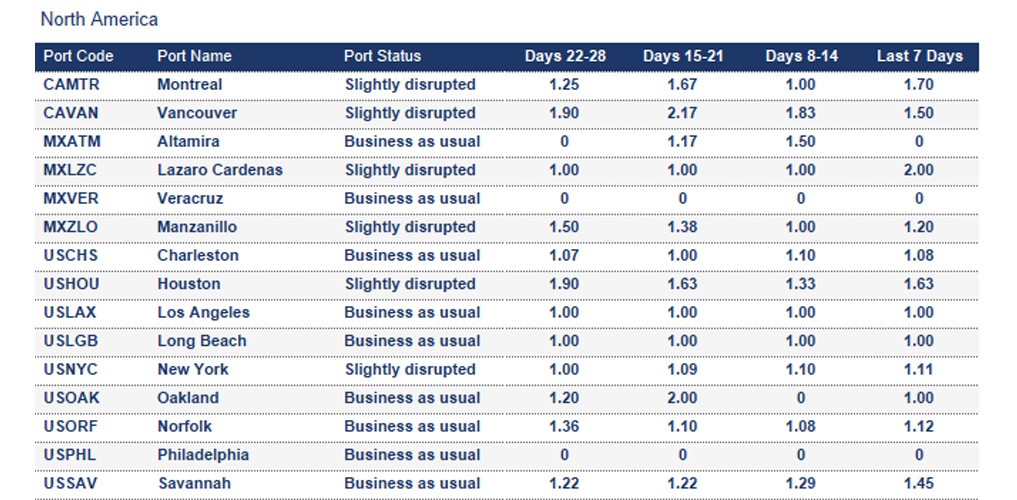
Canada
Average import rail dwell time for Canadian cargo (Vessel arrival to departure rail ramp):
- Halifax: 2 days
- Montreal: 6 days
- Prince Rupert: 5 days
- Saint John: 5 days
- Vancouver: 9 days
Mexico
Ensenada: Carriers have suspended Ensenada port calls due to persistent operational delays and customs-related challenges. New tax structures and inspection backlogs further impact reliability, leaving no regular import service and forcing rerouting via alternative ports. Read more.
Lazaro Cardenas: The 7-day average vessel waiting time is around 2 days. Operations at the port are proceeding regularly. Truck import processing times have improved, decreasing from 72 hours to 48 hours.
Manzanillo: The 7-day average vessel waiting time is around 1.2 days. Operations at Manzanillo have stabilised and are running efficiently. Truck import processing times remain at 72 hours. Rail platform allocation for import cargo has increased from 5 days to 8 days.
United States
Houston: The 7-day average vessel waiting time is around 1.63 days.
Mobile: The 7-day average vessel waiting time is around 2.11 days.
South and Central America
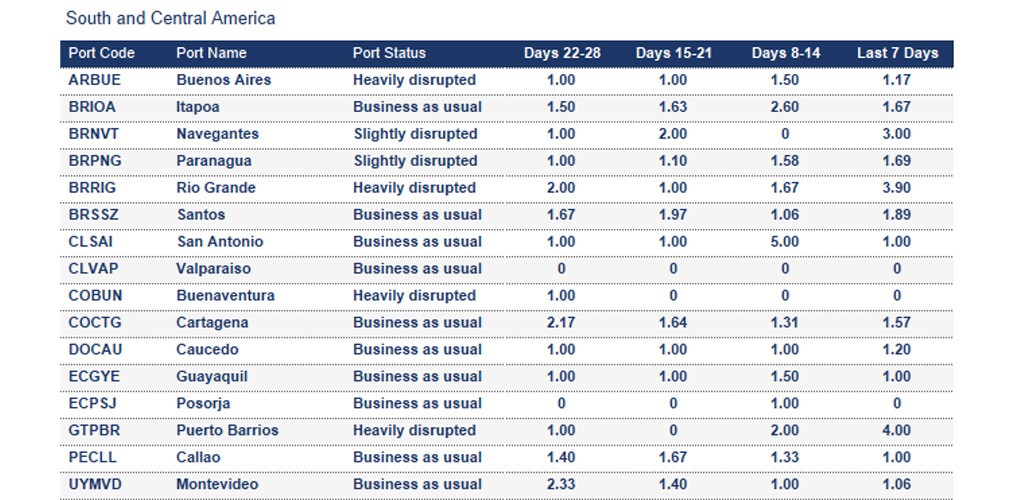
Argentina
Buenos Aires: Carriers report waiting times of up to 5 days. Terminal operations are impacted by high empty container volumes of 800 TEUs. Paraguay transshipments account for 35% of throughput. Vessel delays persist due to cargo surges; occupancy is at 80%. Infrastructure upgrades are underway. TRP operates smoothly at 66% occupancy. Terminal 4 faced disruption from labour action, with yard occupancy at 95%.
Brazil
Navegantes: The 7-day average vessel waiting time is around 3 days.
Paranagua: Carriers report waiting times of up to 4 days. Paranaguá Terminal (TCP) is currently congested, with delays affecting vessels arriving outside their scheduled berthing windows.
Rio De Janeiro: The 7-day average vessel waiting time is around 3 days.
Rio Grande: The 7-day average vessel waiting time is around 3.9 days.
Guatemala
Puerto Barrios: The 7-day average vessel waiting time is 4 days. The yard is experiencing high levels of utilisation at around 88%, primarily due to service reliability issues and a shortage of truck drivers. These factors are adversely affecting the timely release of import cargo.
How Kuehne+Nagel estimates port disruption statuses
Seaexplorer has four port statuses that are estimated based mainly on the 7-day average vessel waiting time. Other factors include yard congestion, labour strikes, natural disasters or intermodal disruptions. Slightly different rules are applied to major ports, or ports that are hubs in their region, as they are typically more efficient.
- Business as usual means the port is currently operating without any significant disruption;
- Slightly disrupted is used if the 7-day average vessel waiting time exceeds 2 days;
- Heavily disrupted is used if the 7-day average vessel waiting time exceeds 4 days; and
- Port closed is used when the port suspends operations due to a major disruptive event.
How Kuehne+Nagel calculates the 7-day average vessel waiting time
Mainline container vessels may spend a certain number of days waiting at designated anchorage areas before their scheduled port call.
To calculate the 7-day average waiting time, we consider the waiting days of these vessels, excluding:
- Waiting times for feeder vessels,
- Idle ships without an announced next port,
- Slow steamers heading toward the anchorage but not actively waiting within the designated area
- Vessels passing through the anchorage area without intending to call at the port.
This rolling average is based on the data from the last seven days and is updated daily in seaexplorer.
To find the latest waiting time for a port, enter the port name or code in the search bar and select the relevant option.
Stay Ahead Stay Informed: Register for seaexplorer for the latest disruptions and vessel waiting times at global container ports.
